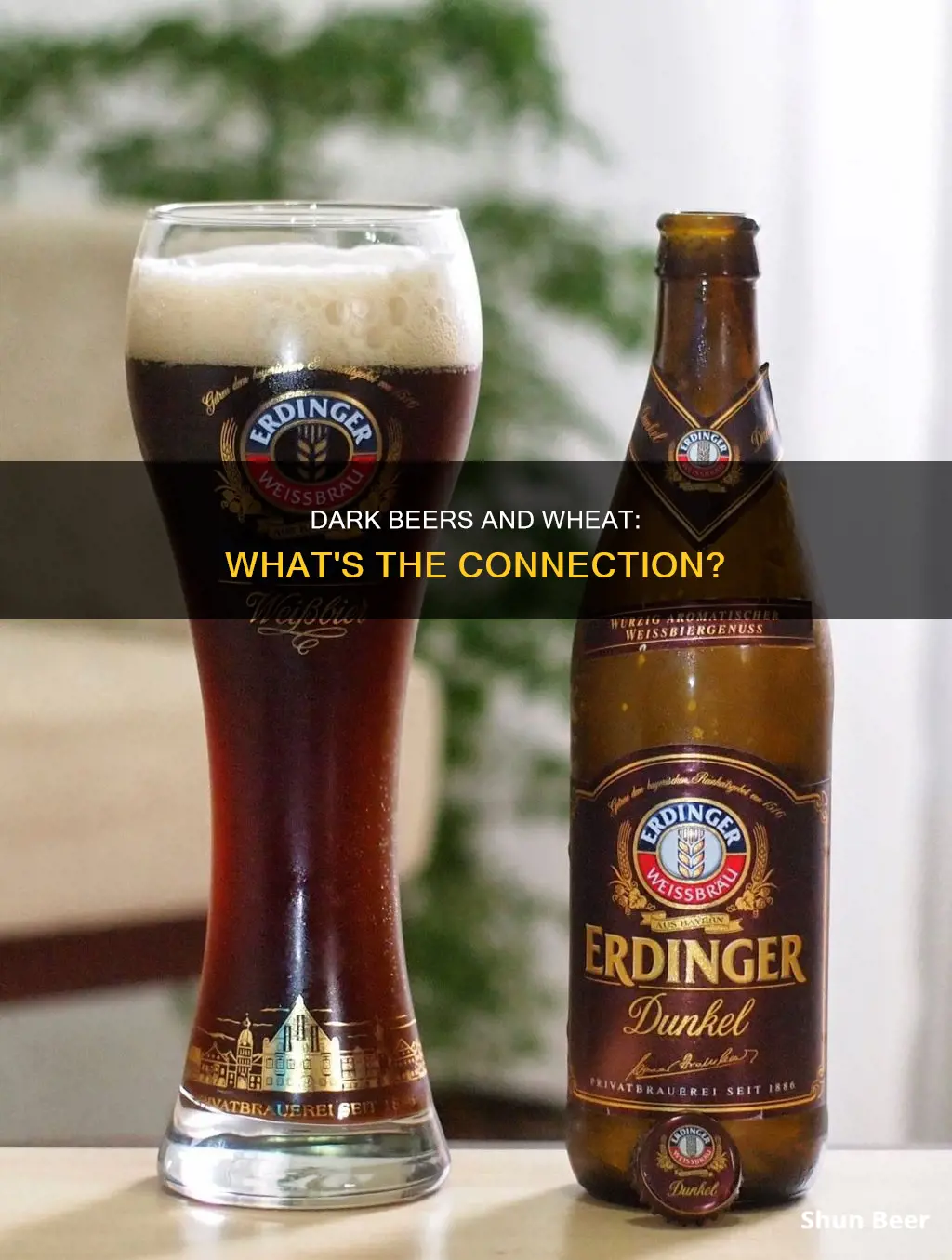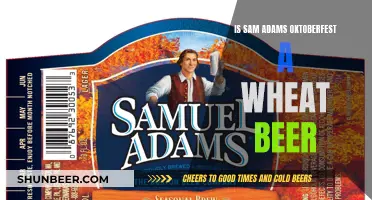
Wheat beers are top-fermented beers that are brewed with a large proportion of wheat relative to the amount of malted barley. The colour of a beer is directly related to its malt content. Darker beers are made with darker, more highly kilned malts. Wheat beers can range in colour from garnet or deep amber to ruby brown. An example of a dark wheat beer is Dunkelweizen, which is a German variety.
What You'll Learn

Wheat beers can darken in the bottle
Additionally, the use of extracts such as liquid or dry malt extract can lead to darkening. This is because extracts tend to make a darker beer, pound for pound, than dry extracts. If the extract is added to the boil too early or on high heat, it can burn and caramelise, resulting in a darker beer. This is a common issue with wheat beers, as wheat extracts tend to brown more than other types.
To avoid darkening, it is recommended to take the pot off the heat completely before adding the extract, stirring it vigorously, and then returning it to the burner. Using dry extracts instead of liquid extracts can also help, as they tend to stay lighter. Another option is to switch to all-grain brewing, which can give more control over the final colour of the beer.
It is also worth noting that the colour of beer can be darker when viewed in a carboy or large volume container compared to when it is poured into a glass. This is because the larger volume can make the beer appear darker, and the glass can also affect the colour perception.
Kolsch Beers: Wheat or Not?
You may want to see also

Dark beers are not necessarily heavy or high in calories
It is a common misconception that dark beers are heavy and high in calories. While dark beers are often associated with rich, full flavours, this does not necessarily mean that they have more calories than lighter beers. The calorie content of a beer is primarily determined by its alcohol content and residual sugars.
Dark beers are typically made with roasted malts, which give them their distinct colour and flavour. However, the roasting process does not significantly impact the calorie content of the beer. The calorie content of beer is mainly determined by the alcohol content, with alcohol contributing 7 calories per gram. So, a beer with a higher alcohol content will generally have more calories.
Dark beers can have varying levels of alcohol, just like any other beer style. Stouts, porters, and black lagers can have an alcohol content of around four to five per cent, which can be lower than some light beers. For example, a serving of Guinness has 125 calories, while a Bud Light has 110 calories. Similarly, Samuel Adams' Black Lager, a light-bodied beer with a 4.9 per cent ABV, has under 200 calories in a 12-ounce serving. In contrast, a highly carbonated, pale-coloured beer like Victory Brewing Co.'s Golden Monkey, with a 9.5 per cent ABV, has over 300 calories in a 12-ounce serving.
While dark beers may not always have more calories, they do tend to be more filling. The roasted malts used in the brewing process contribute to a fuller mouthfeel, which can be satisfying for those watching their calorie intake. Additionally, some breweries add ingredients like chocolate or coffee to enhance the flavour profile of their dark beers, which can contribute to a slightly higher calorie count, although the difference is usually minimal.
In conclusion, dark beers are not necessarily heavy or high in calories. The calorie content of beer depends on various factors, such as alcohol content, residual sugars, ingredients, brewing process, and serving size. It is important to consider these factors and check the nutritional information provided by the brewery to make an informed choice. Enjoying a dark beer in moderation can be part of a balanced lifestyle, and with the variety of options available, there is no need to avoid them altogether.
Witbier and Wheat Beer: What's the Difference?
You may want to see also

Wheat beers are top-fermented
Weißbier (German for "white beer") is made with at least 52% wheat to barley malt, resulting in a light-coloured, top-fermenting beer. Witbier (Dutch for "white beer") uses flavourings such as coriander and orange peel, and Belgian white beers are often made with raw, unmalted wheat.
Wheat beers are typically fermented in open, wide, shallow pans known as "coolships". The yeast used in top fermentation is called Saccharomyces Cerevisiae, and it tends to accumulate and float to the surface of the wort—hence the term "top". Top fermentation occurs at "warm" temperatures of around 95°F (35°C), although in practice, it is usually carried out at 68-70°F (20-21°C) to favour the release of the yeast's flavour byproducts, such as fruitiness from esters and bitterness from tannins.
Bavarian wheat beers typically consist of 50% wheat and 50% barley, while American wheat beers usually contain 20-30% wheat. The type of yeast used also plays a crucial role in the flavour and aroma of wheat beers. For instance, a traditional Bavarian-style yeast strain gives the beer a rich and complex flavour and aroma, while a standard American ale yeast results in a lighter, less intense taste.
The difference in texture between barley and wheat affects the lautering process. Wheat has more protein, which slows down the run-off during lautering. However, this higher protein content also contributes to a nicer head when the beer is poured.
The Pilsner and Wheat Beer Divide: What Sets Them Apart?
You may want to see also

American Dark Wheat Beer is an Americanised version of Dunkelweizen
Flavours of caramel and toasted malts might be present, but unlike German Weizen beers, they do not have flavours and aromas of banana esters and clove-like phenols. American Dark Wheat Beer typically has an ABV of 4.0%–8.0% and an IBU of 10–35. It is typically served in a Weizen glass.
Wheat beer is a top-fermented beer brewed with a large proportion of wheat relative to the amount of malted barley. The two main varieties are German Weizenbier and Belgian witbier, but other types include Lambic (made with wild yeast), Berliner Weisse (a cloudy, sour beer), and Gose (a sour, salty beer).
German Weizenbier, or Hefeweizen, is traditionally from Bavaria and has a significant proportion of malted barley replaced with malted wheat. It is known for its low hop bitterness and high carbonation. The Hefeweizen style is also characterised by its phenolic character, with flavours described as "clove" and "medicinal".
American wheat beer is typically brewed with at least 30% malted wheat and can be made using either ale or lager yeast. It is usually served unfiltered and has a cloudy appearance. It is typically hoppier than its German counterpart and does not have flavours of banana or clove, which are indicative of the weizen yeast strain. American wheat beer is known worldwide as a refreshing summer style.
Lagers and Wheat Beers: What's the Difference?
You may want to see also

Wheat beers are not gluten-free
German Weizenbier, or Hefeweizen, is a wheat beer traditionally from Bavaria, where a significant proportion of malted barley is replaced with malted wheat. By law, Weizenbiers brewed in Germany must use a "top-fermenting" yeast. Specialized yeast strains produce banana and clove overtones as by-products of fermentation. The Hefeweizen style is known for its low hop bitterness and relatively high carbonation.
Belgian witbiers, or "white beers", are brewed mainly in Belgium and the Netherlands. They are called "white beers" because the suspended yeast and wheat proteins make the beer look hazy or white when cold. Witbiers usually contain a blend of spices such as coriander, orange, and bitter orange, in addition to hops.
While wheat beers are not gluten-free, there are gluten-free beers available that are made with alternative grains such as sorghum, rice, buckwheat, millet, corn, quinoa, or oats. Some breweries are dedicated gluten-free breweries, meaning they do not handle gluten-containing ingredients at all.
Gluten-removed and gluten-reduced beers are also available, but these may not be suitable for people with a severe gluten intolerance or allergy. These beers are made from gluten-containing grains like barley, wheat, or rye, and processed using enzymes that break down gluten particles. However, the effectiveness of this process has not been scientifically validated, and the gluten content may vary between batches.
Belgian Beers: Wheat-Based Brews or Not?
You may want to see also
Frequently asked questions
Yes, dark beers can contain wheat. Dunkelweizen, for example, is a German dark wheat beer.
Wheat beer is a top-fermented beer brewed with a large proportion of wheat relative to the amount of malted barley. The two main varieties are German Weizenbier and Belgian Witbier.
Wheat beers are often cloudy with long-lasting heads, light- to medium-bodied, and highly carbonated. They can have low to moderately high hop bitterness and may exhibit fruity, clove-like, or banana flavours.
Some examples of dark wheat beers include Dunkelweizen, Weizenbock, and American Dark Wheat Beer.







